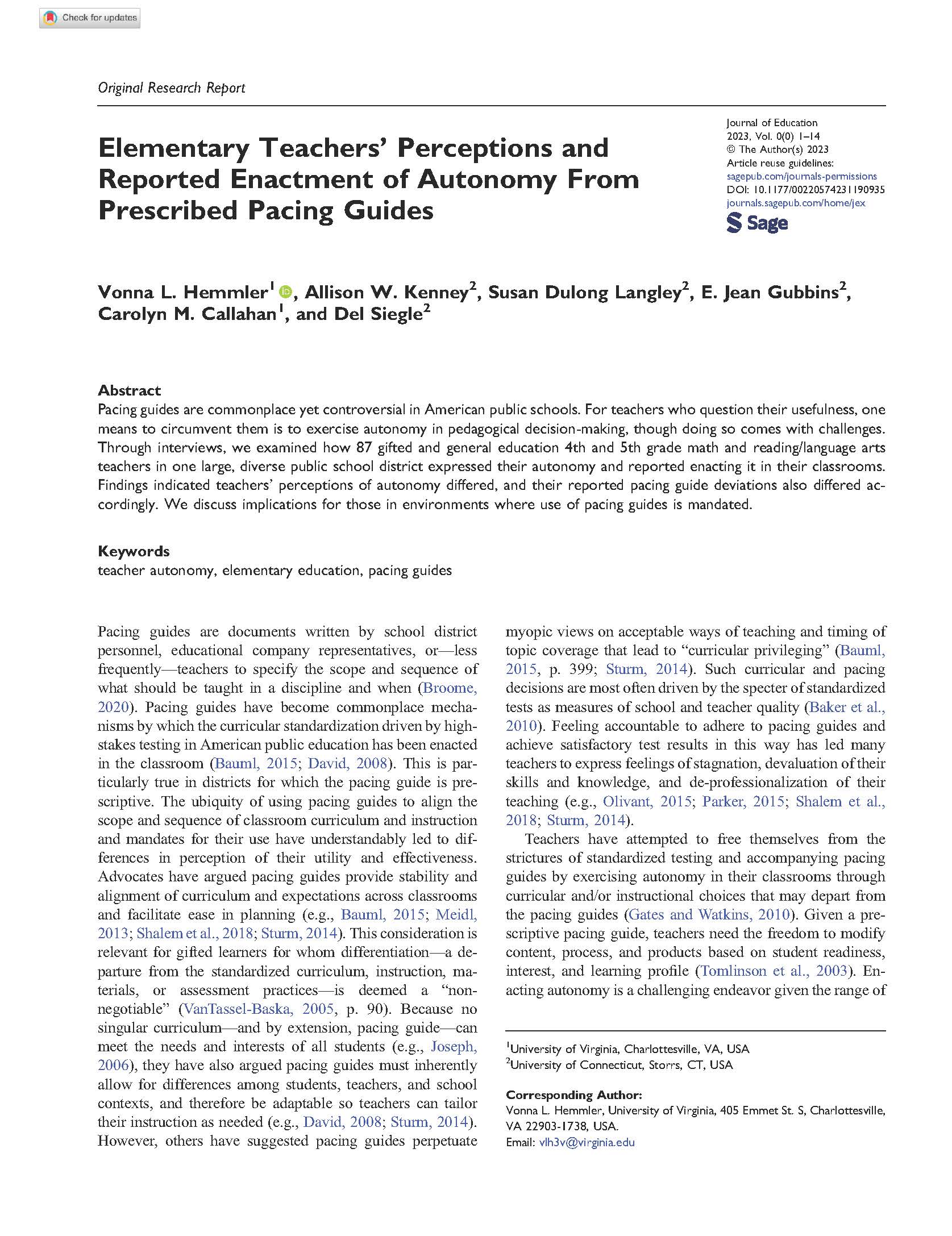Elementary Teachers’ Perceptions and Reported Enactment of Autonomy From Prescribed Pacing Guides
Journal of Education
2024, Vol. 204, No. 3
First published online July 22, 2023
Vonna L. Hemmler, Allison W. Kenney, Susan Dulong Langley, E. Jean Gubbins, Carolyn M. Callahan, and Del Siegle
# # #
Pacing guides are commonplace yet controversial in American public schools. For teachers who question their usefulness, one means to circumvent them is to exercise autonomy in pedagogical decision-making, though doing so comes with challenges. Through interviews, we examined how 87 gifted and general education 4th and 5th grade math and reading/language arts teachers in one large, diverse public school district expressed their autonomy and reported enacting it in their classrooms. Findings indicated teachers’ perceptions of autonomy differed, and their reported pacing guide deviations also differed accordingly. We discuss implications for those in environments where use of pacing guides is mandated.
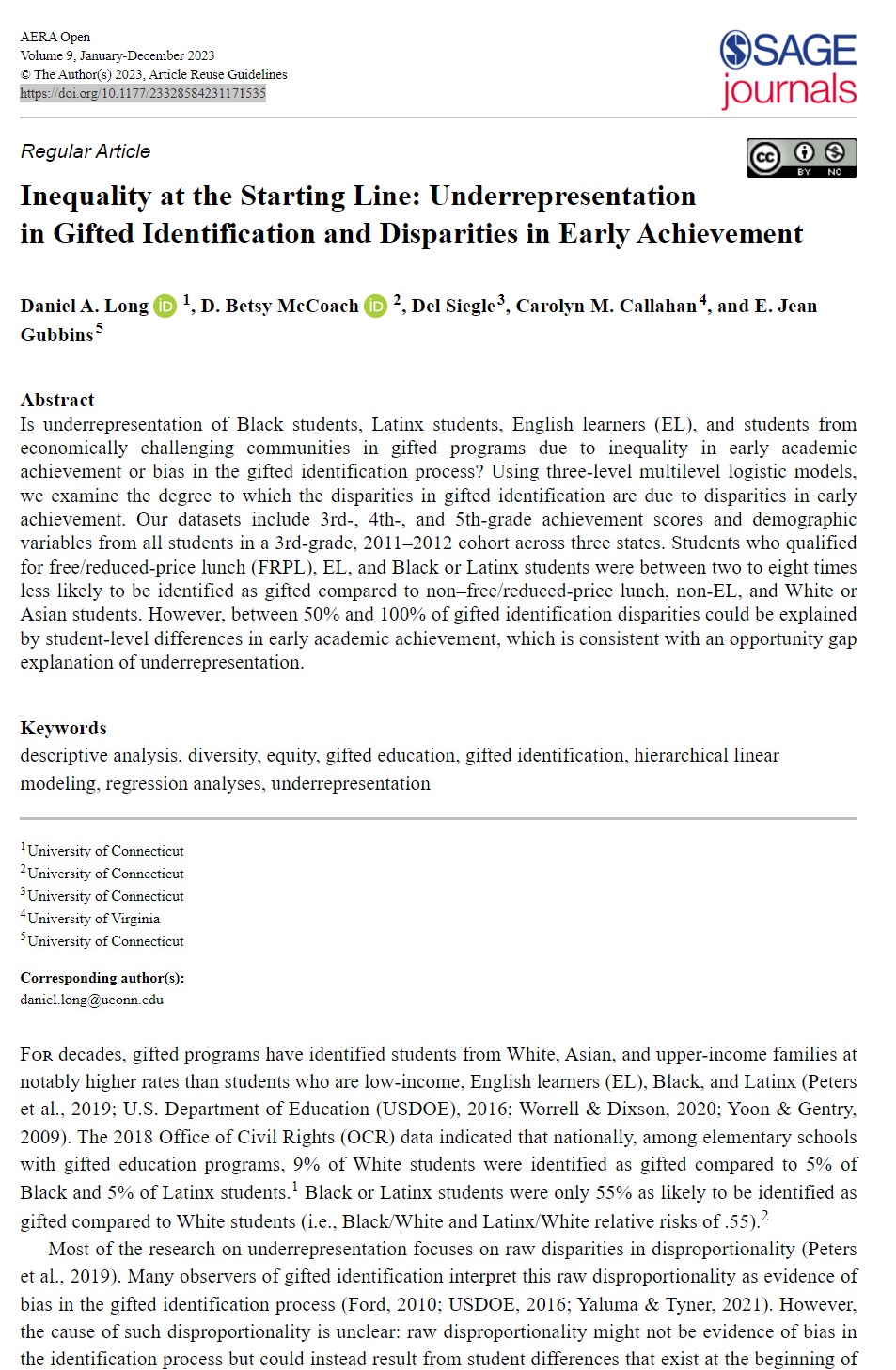
Inequality at the Starting Line: Underrepresentation in Gifted Identification and Disparities in Early Achievement
AERA Open
January – December 2023, Vol. 9
Daniel A. Long, D. Betsy McCoach, Del Siegle, Carolyn M. Callahan, and E. Jean Gubbins
# # #
Is underrepresentation of Black students, Latinx students, English learners (EL), and students from economically challenging communities in gifted programs due to inequality in early academic achievement or bias in the gifted identification process? Using three-level multilevel logistic models, we examine the degree to which the disparities in gifted identification are due to disparities in early achievement. Our datasets include 3rd-, 4th-, and 5th-grade achievement scores and demographic variables from all students in a 3rd-grade, 2011–2012 cohort across three states. Students who qualified for free/reduced-price lunch (FRPL), EL, and Black or Latinx students were between two to eight times less likely to be identified as gifted compared to non–free/reduced-price lunch, non-EL, and White or Asian students. However, between 50% and 100% of gifted identification disparities could be explained by student-level differences in early academic achievement, which is consistent with an opportunity gap explanation of underrepresentation.
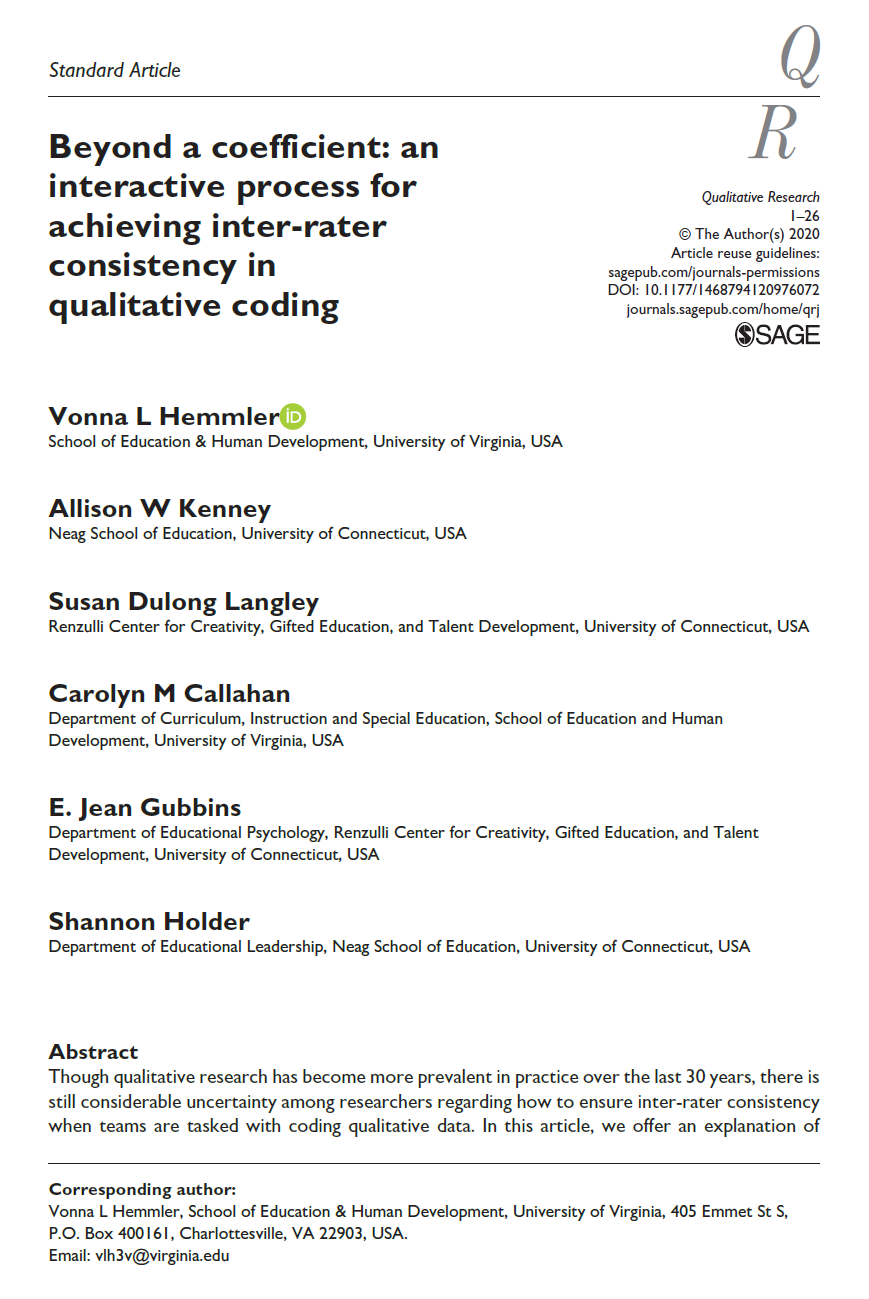
Beyond a Coefficient: An Interactive process for achieving Inter-rater Consistency in Qualitative Coding
Qualitative Research
April 2022, Vol. 22, No. 2
Vonna L. Hemmler, Allison W. Kenney, Susan D. Langley, Carolyn M. Callahan, E. Jean Gubbins, and Shannon Holder
# # #
Though qualitative research has become more prevalent in practice over the last 30 years, there is still considerable uncertainty among researchers regarding how to ensure inter-rater consistency when teams are tasked with coding qualitative data. In this article, we offer an explanation of a methodology that our qualitative team used to achieve systematic coding of our dataset in a way that preserved the contextual, subjective nature of the data, lent itself to the deductive and inductive creation of a layered codebook, and ensured consistent application of the codebook to varied types of data. This methodology prepared us to draw logical and substantiated conclusions during subsequent analyses; hence, the process serves as a welcome addition to the literature on consistently coding qualitative data in a manner that honors its defining characteristics.
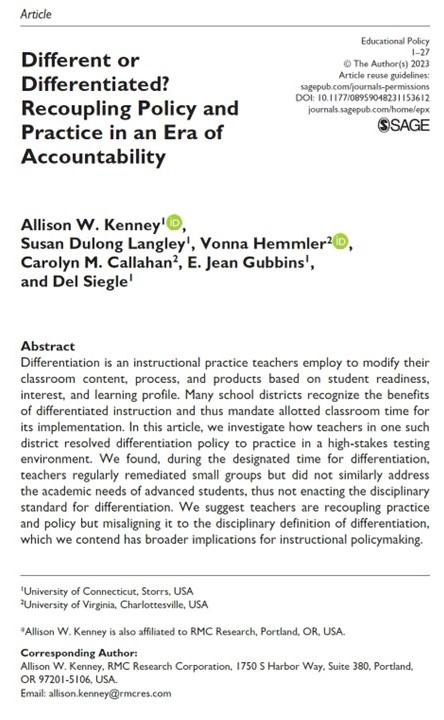
Different or Differentiated? Recoupling Policy and Practice in an Era of Accountability
Educational Policy
2024, Vol. 34, No. 1
https://doi.org/10.1177/08959048231153612
Allison W. Kenney, Susan Dulong Langley, Vonna Hemmler, Carolyn M. Callahan, E. Jean Gubbins, and Del Siegle
# # #
Differentiation is an instructional practice teachers employ to modify their classroom content, process, and products based on student readiness, interest, and learning profile. Many school districts recognize the benefits of differentiated instruction and thus mandate allotted classroom time for its implementation. In this article, we investigate how teachers in one such district resolved differentiation policy to practice in a high-stakes testing environment. We found, during the designated time for differentiation, teachers regularly remediated small groups but did not similarly address the academic needs of advanced students, thus not enacting the disciplinary standard for differentiation. We suggest teachers are recoupling practice and policy but misaligning it to the disciplinary definition of differentiation, which we contend has broader implications for instructional policymaking.
Gifted Child Quarterly 2022 Paper of the Year

Identifying and Serving Gifted and Talented Students: Are Identification and Services Connected?
Gifted Child Quarterly
January 2021, Vol. 85, No. 2
https://doi.org/10.1177/0016986220988308
E. Jean Gubbins, Del Siegle, Karen Ottone-Cross, D. Betsy McCoach, Susan Dulong Langley, Carolyn M. Callahan, Annalissa V. Brodersen, and Melanie Caughey
# # #
The importance of alignment between identification processes and program design is widely noted in gifted and talented education literature. We analyzed publicly available district gifted program plans (Grades 3-5) from two states to examine the extent to which district identification practices matched intervention strategies. Our team developed a coding scheme matrix with 133 items for State 1 (n = 115) and State 2 (n = 178). The results of this study indicated that, at least in terms of planning, districts in the two states we examined appeared to be aligning identification and programming practices to meet the needs of gifted students identified in mathematics and/or reading/English language arts. In State 1, at least 60% of the districts reported the following intervention strategies in mathematics and reading/English language arts: faster pace of coverage, regular grade-level standards, in-depth coverage, preassessment, above grade-level standards, and expanded grade-level standards. In contrast, State 2 districts reported faster pace of coverage; however, with less commonly utilized interventions, subject-matter identification significantly influenced their usage. Differentiation was the primary learning environment strategy utilized by districts in both states.
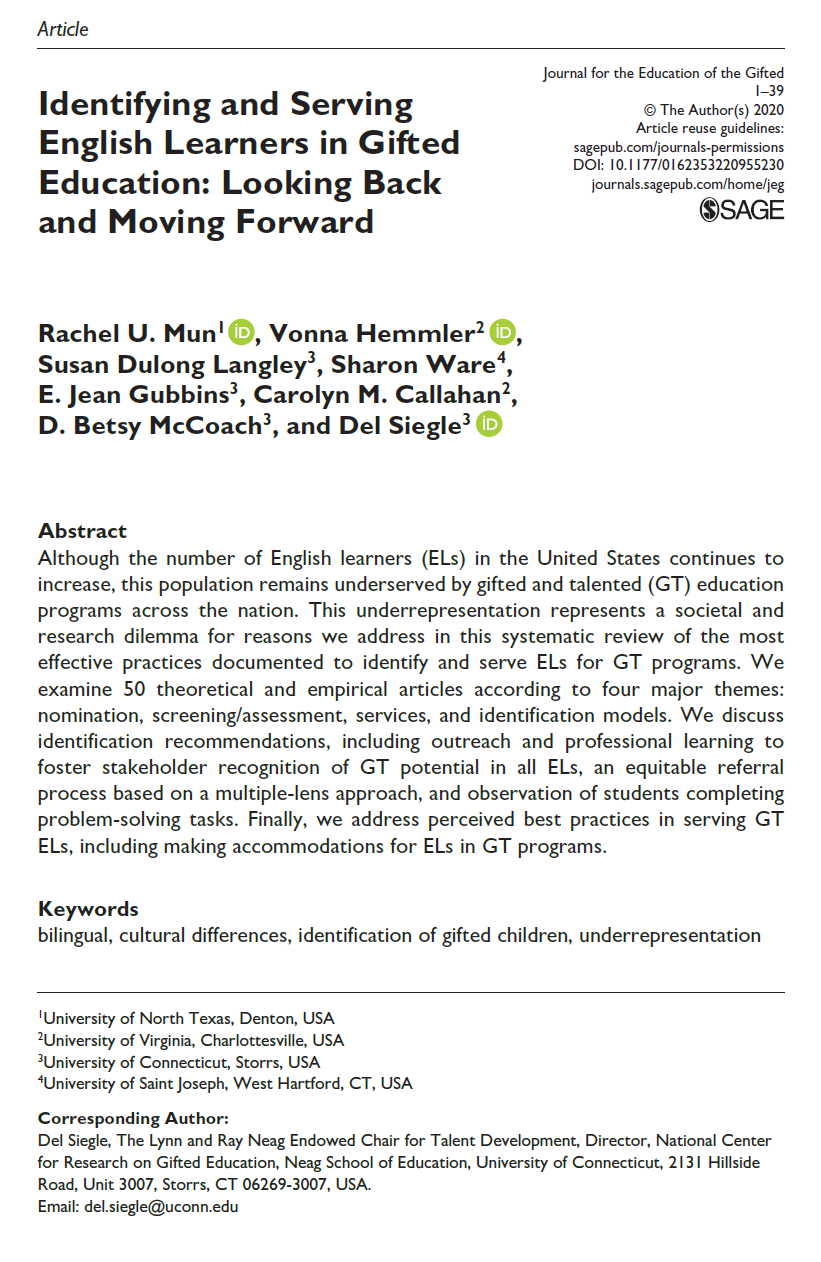
Identifying and Serving English Learners in Gifted Education: Looking Back and Moving Forward
Journal for the Education of the Gifted.
December 2020, Vol. 43, No. 4
Rachel U. Mun, Vonna Hemmler, Susan Dulong Langley, Sharon Ware, E. Jean Gubbins, Carolyn M. Callahan, D. Betsy McCoach, and Del Siegle
# # #
Although the number of English learners (ELs) in the United States continues to increase, this population remains underserved by gifted and talented (GT) education programs across the nation. This underrepresentation represents a societal and research dilemma for reasons we address in this systematic review of the most effective practices documented to identify and serve ELs for GT programs. We examine 50 theoretical and empirical articles according to four major themes: nomination, screening/assessment, services, and identification models. We discuss identification recommendations, including outreach and professional learning to foster stakeholder recognition of GT potential in all ELs, an equitable referral process based on a multiple-lens approach, and observation of students completing problem-solving tasks. Finally, we address perceived best practices in serving GT ELs, including making accommodations for ELs in GT programs.
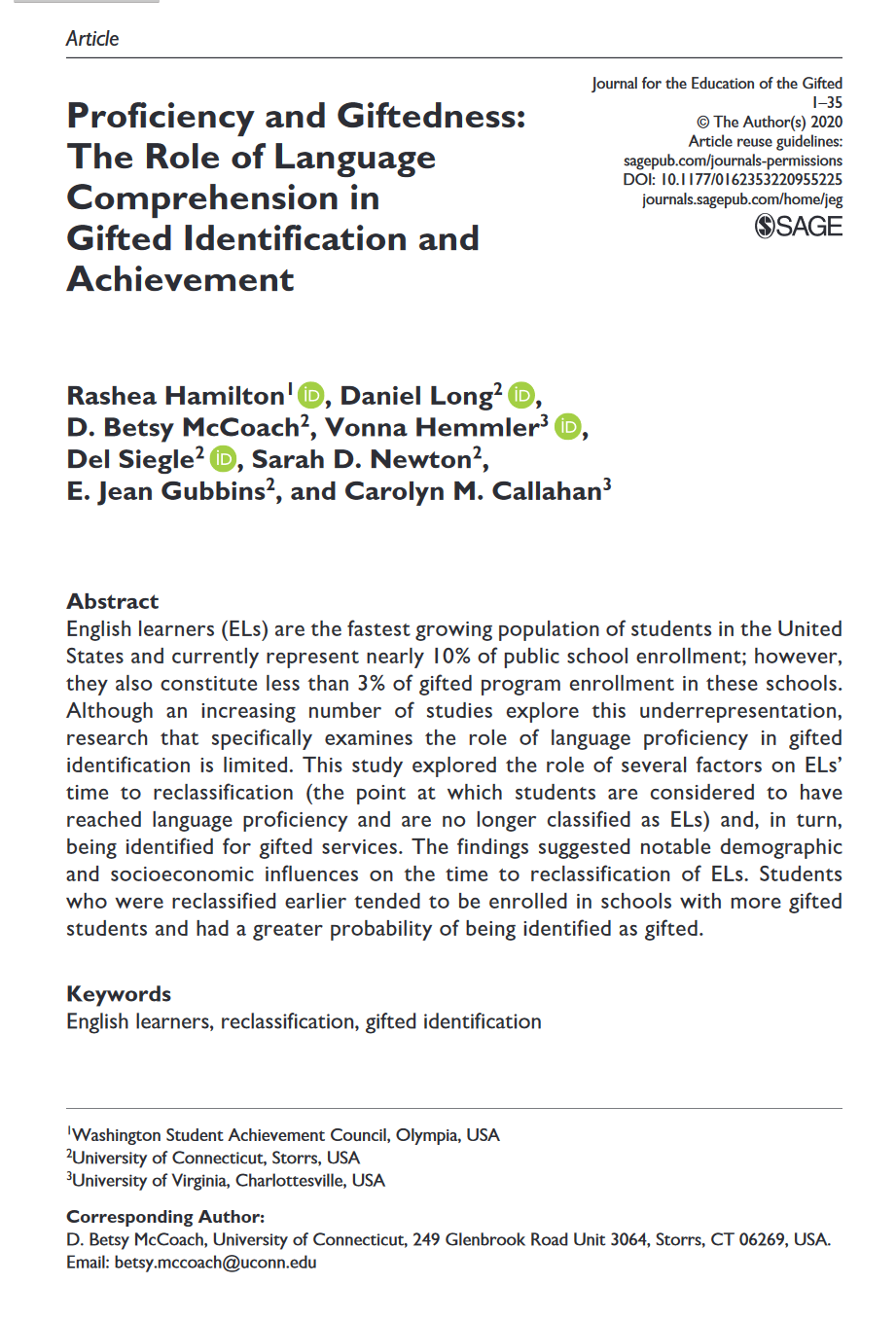
Proficiency and Giftedness: The Role of Language Comprehension in Gifted Identification and Achievement
Journal for the Education of the Gifted
December 2020, Vol. 43, No. 4
Rashea Hamilton, Daniel Long, D. Betsy McCoach, Vonna Hemmler, Del Siegle, Sarah D. Newton, E. Jean Gubbins, and Carolyn M. Callahan
# # #
English learners (ELs) are the fastest growing population of students in the United States and currently represent nearly 10% of public school enrollment; however, they also constitute less than 3% of gifted program enrollment in these schools. Although an increasing number of studies explore this underrepresentation, research that specifically examines the role of language proficiency in gifted identification is limited. This study explored the role of several factors on ELs’ time to reclassification (the point at which students are considered to have reached language proficiency and are no longer classified as ELs) and, in turn, being identified for gifted services. The findings suggested notable demographic and socioeconomic influences on the time to reclassification of ELs. Students who were reclassified earlier tended to be enrolled in schools with more gifted students and had a greater probability of being identified as gifted.
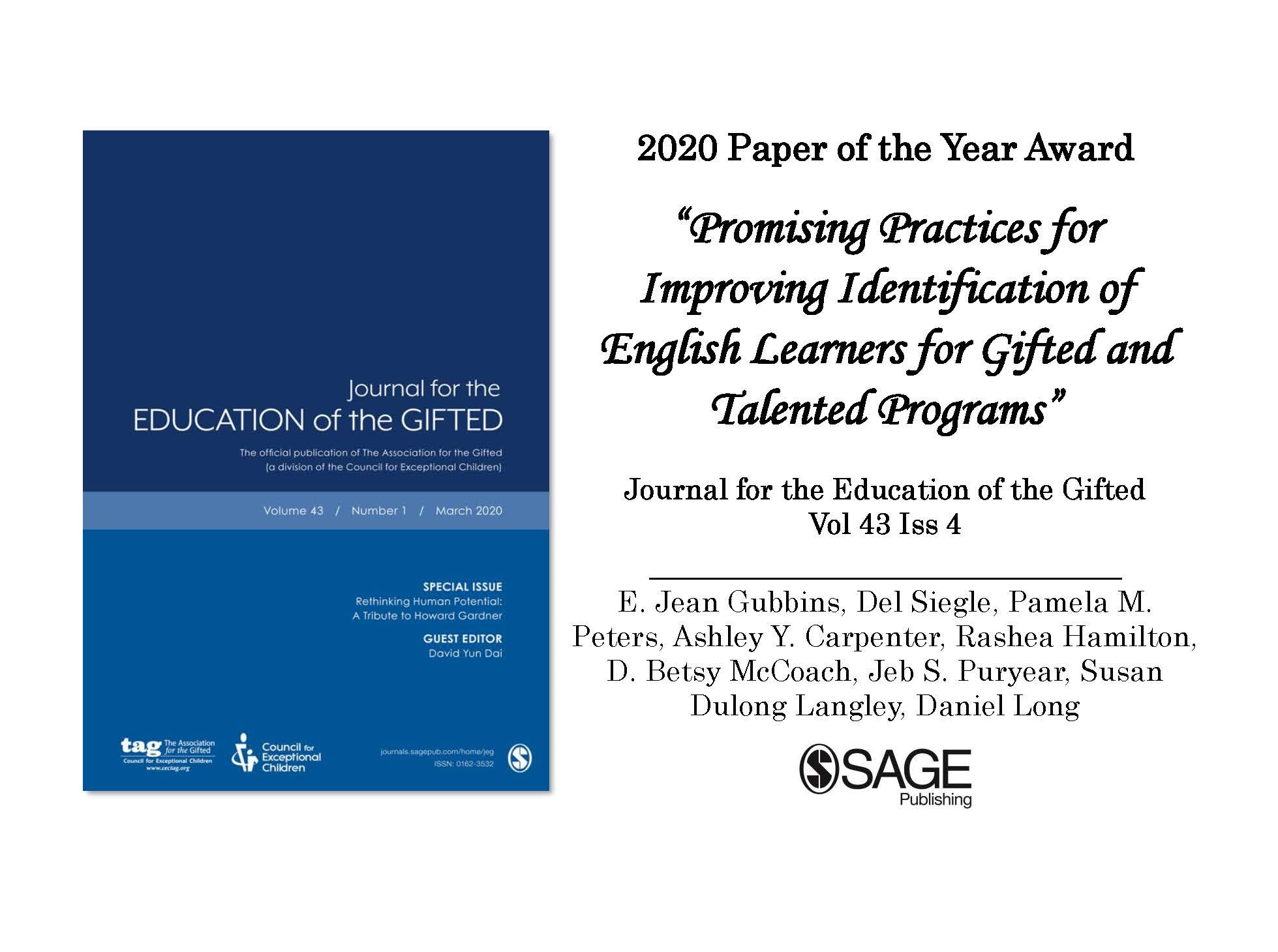
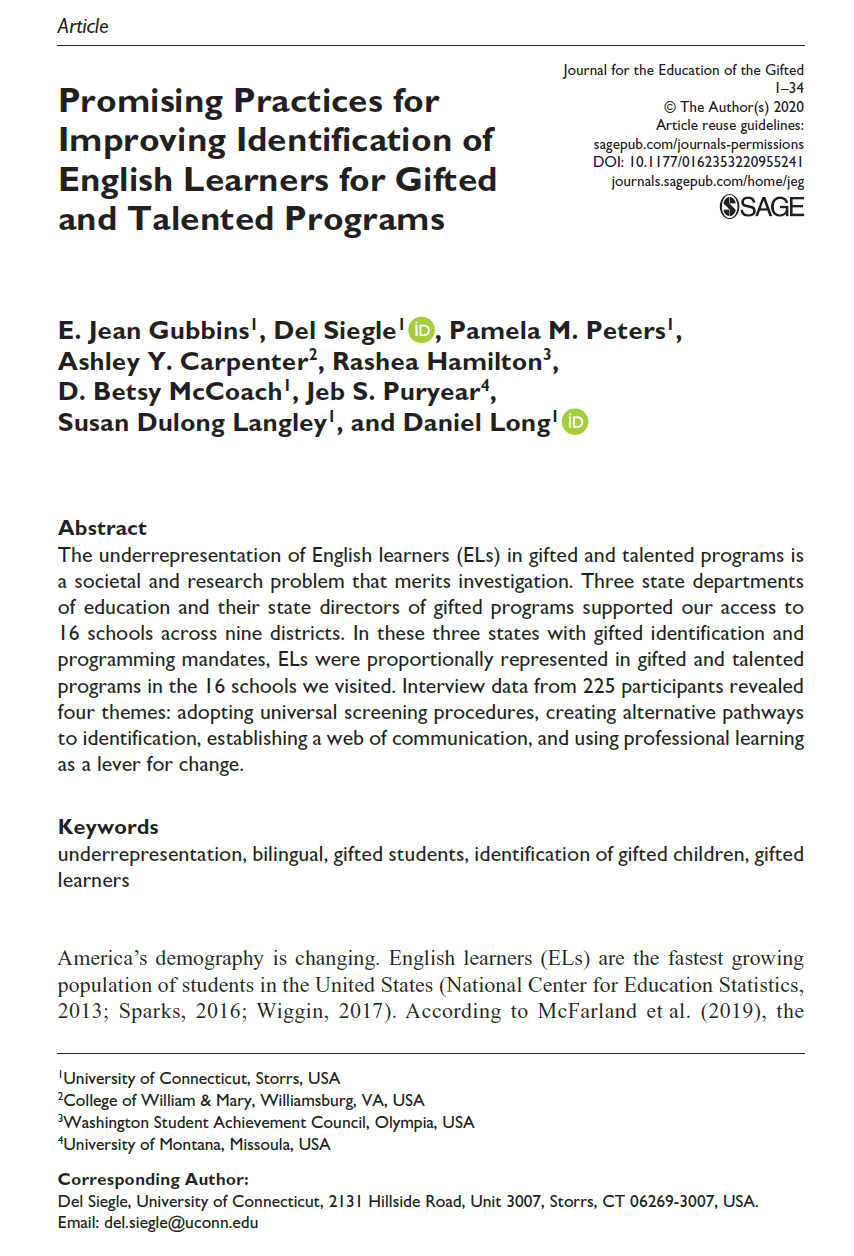
Promising Practices for Improving Identification of English Learners for Gifted and Talented Programs
Journal for the Education of the Gifted
December 2020, Vol. 43, No. 4
E. Jean Gubbins, Del Siegle , Pamela M. Peters, Ashley Y. Carpenter, Rashea Hamilton, D. Betsy McCoach, Jeb S. Puryear, Susan Dulong Langley, and Daniel Long
# # #
The underrepresentation of English learners (ELs) in gifted and talented programs is a societal and research problem that merits investigation. Three state departments of education and their state directors of gifted programs supported our access to 16 schools across nine districts. In these three states with gifted identification and programming mandates, ELs were proportionally represented in gifted and talented programs in the 16 schools we visited. Interview data from 225 participants revealed four themes: adopting universal screening procedures, creating alternative pathways to identification, establishing a web of communication, and using professional learning as a lever for change.
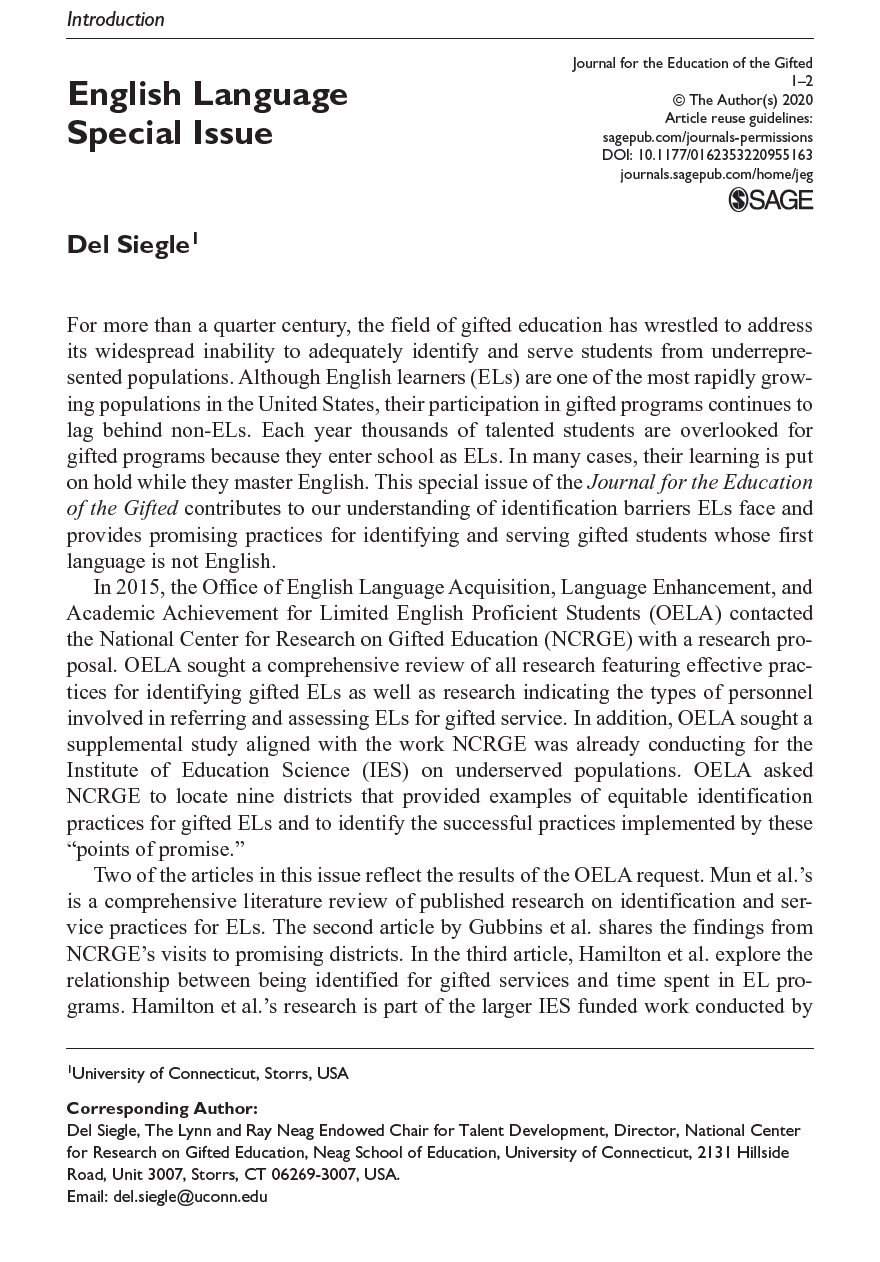
Introduction to English Language Special Issue
Journal for the Education of the Gifted
December 2020, Vol. 43, No. 4
Del Siegle
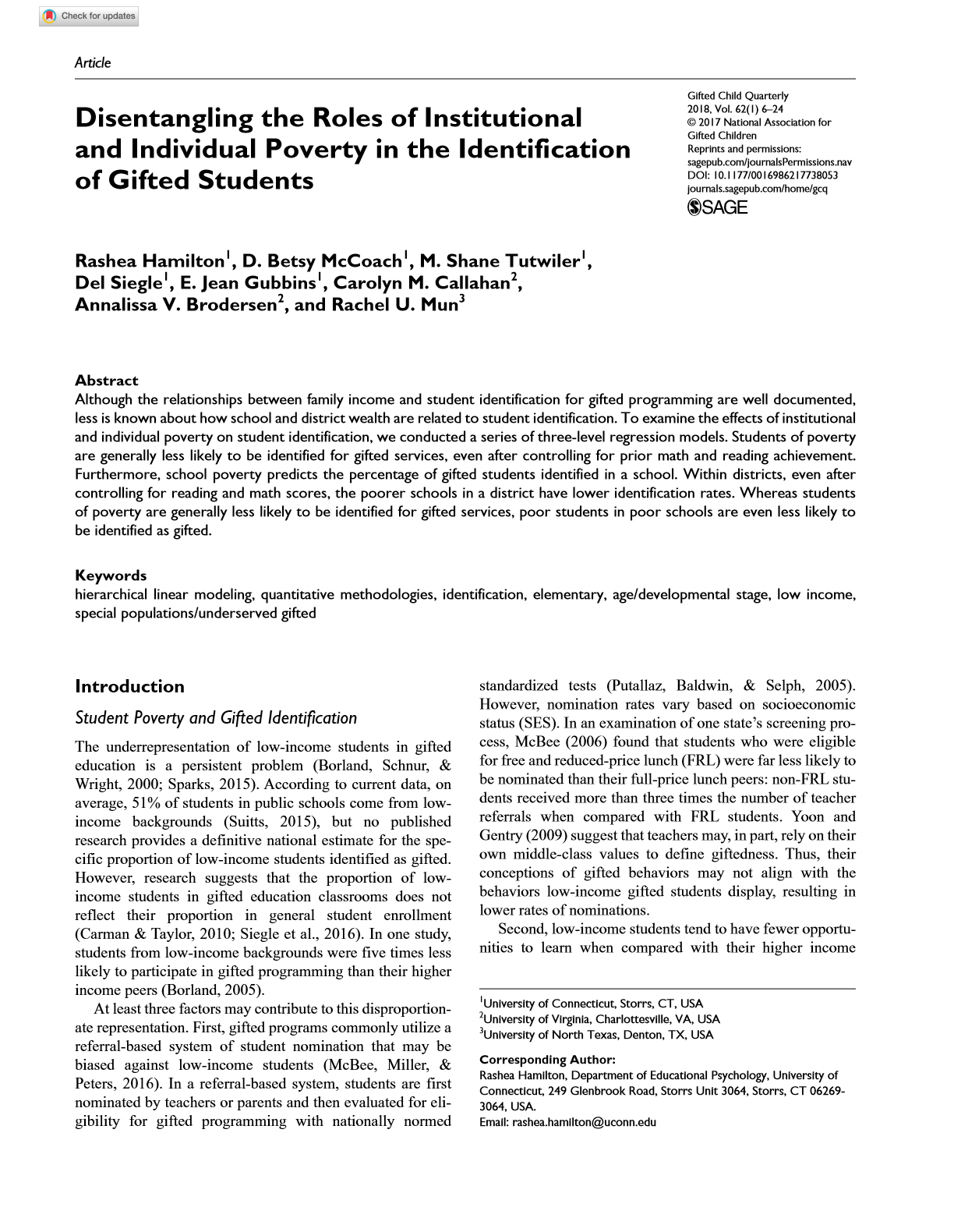
Disentangling the Roles of Institutional and Individual Poverty in the Identification of Gifted Students
Gifted Child Quarterly
January 2018, Vol. 62, No. 1, Pages 6-24
Rashea Hamilton, D. Betsy McCoach, M. Shane Tutwiler, Del Siegle, E. Jean Gubbins, Carolyn Callahan, Annalissa V. Brodersen, and Rachel U. Mun
# # #
Although the relationships between family income and student identification for gifted programming are well documented, less is known about how school and district wealth are related to student identification. To examine the effects of institutional and individual poverty on student identification, we conducted a series of three-level regression models. Students of poverty are generally less likely to be identified for gifted services, even after controlling for prior math and reading achievement. Furthermore, school poverty predicts the percentage of gifted students identified in a school. Within districts, even after controlling for reading and math scores, the poorer schools in a district have lower identification rates. Whereas students of poverty are generally less likely to be identified for gifted services, poor students in poor schools are even less likely to be identified as gifted.
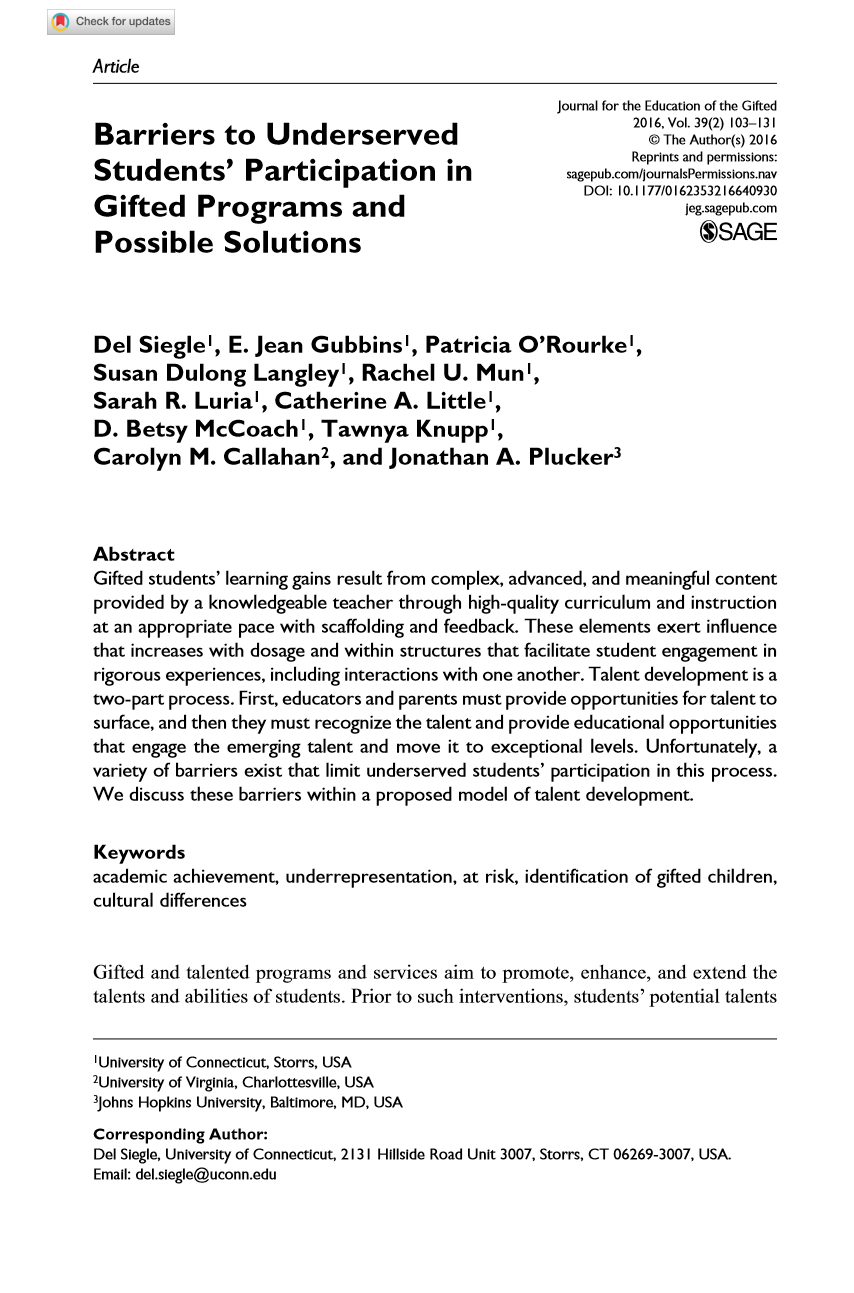
Barriers to Underserved Students’ Participation in Gifted Programs and Possible Solutions
Journal for the Education of the Gifted
June 2016, Vol. 39, No. 2, Pages 103-131
Del Siegle, E. Jean Gubbins, Patricia O’Rourke, Susan Dulong Langley, Rachel U. Mun, Sarah R. Luria, Catherine A. Little, D. Betsy McCoach, Tawnya Knupp, Carolyn M. Callahan, and Jonathan A. Plucker
# # #
Gifted students’ learning gains result from complex, advanced, and meaningful content provided by a knowledgeable teacher through high-quality curriculum and instruction at an appropriate pace with scaffolding and feedback. These elements exert influence that increases with dosage and within structures that facilitate student engagement in rigorous experiences, including interactions with one another. Talent development is a two-part process. First, educators and parents must provide opportunities for talent to surface, and then they must recognize the talent and provide educational opportunities that engage the emerging talent and move it to exceptional levels. Unfortunately, a variety of barriers exist that limit underserved students’ participation in this process. We discuss these barriers within a proposed model of talent development.
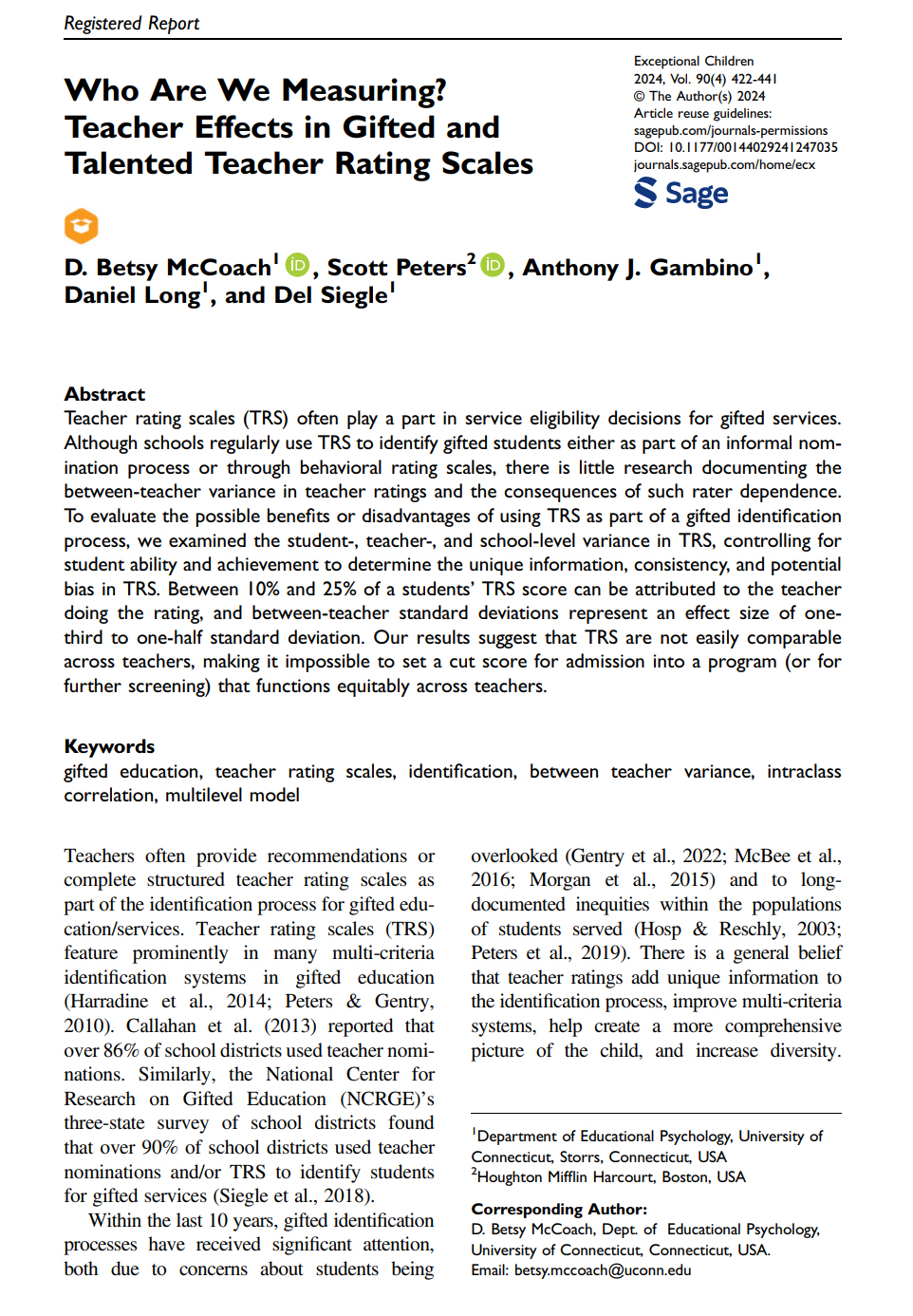
Who Are We Measuring? Teacher Effects in Gifted and Talented Teacher Rating Scales
Exceptional Children
2024, Vol. 90, No. 4
doi:10.1177/00144029241247035
D. Betsy McCoach, Scott Peters, Anthony J. Gambino, Daniel A. Long, and Del Siegle
# # #
Teacher rating scales (TRS) often play a part in service eligibility decisions for gifted services. Although schools regularly use TRS to identify gifted students either as part of an informal nomination process or through behavioral rating scales, there is little research documenting the between-teacher variance in teacher ratings and the consequences of such rater dependence. To evaluate the possible benefits or disadvantages of using TRS as part of a gifted identification process, we examined the student-, teacher-, and school-level variance in TRS, controlling for student ability and achievement to determine the unique information, consistency, and potential bias in TRS. Between 10% and 25% of a students’ TRS score can be attributed to the teacher doing the rating, and between-teacher standard deviations represent an effect size of one-third to one-half standard deviation. Our results suggest that TRS are not easily comparable across teachers, making it impossible to set a cut score for admission into a program (or for further screening) that functions equitably across teachers.
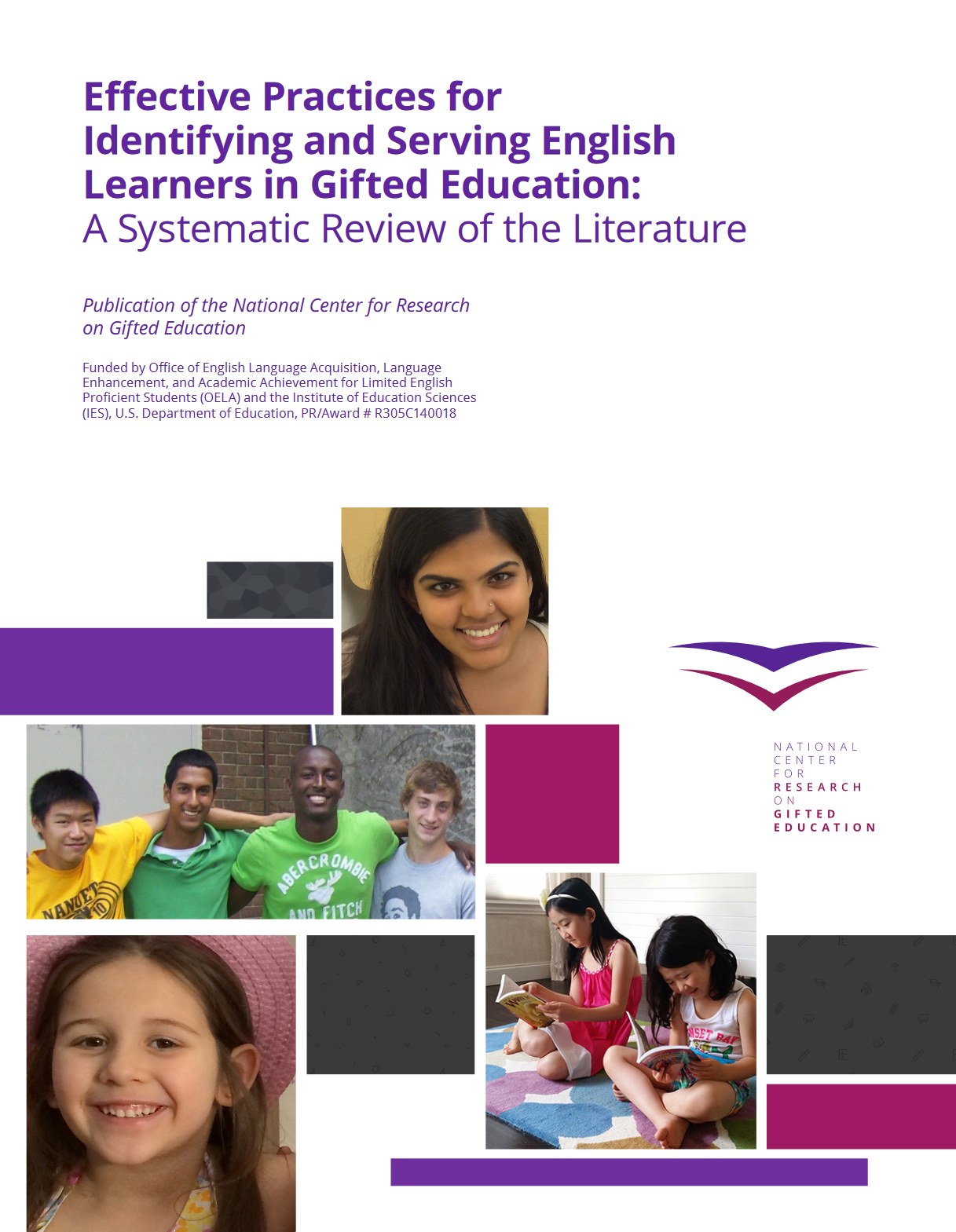
2016 Publication of the National Center for Research on Gifted Education
Rachel U. Mun, Susan Dulong Langley, Sharon Ware, E. Jean Gubbins, Del Siegle, Carolyn M. Callahan, D. Betsy McCoach, and Rashea Hamilton
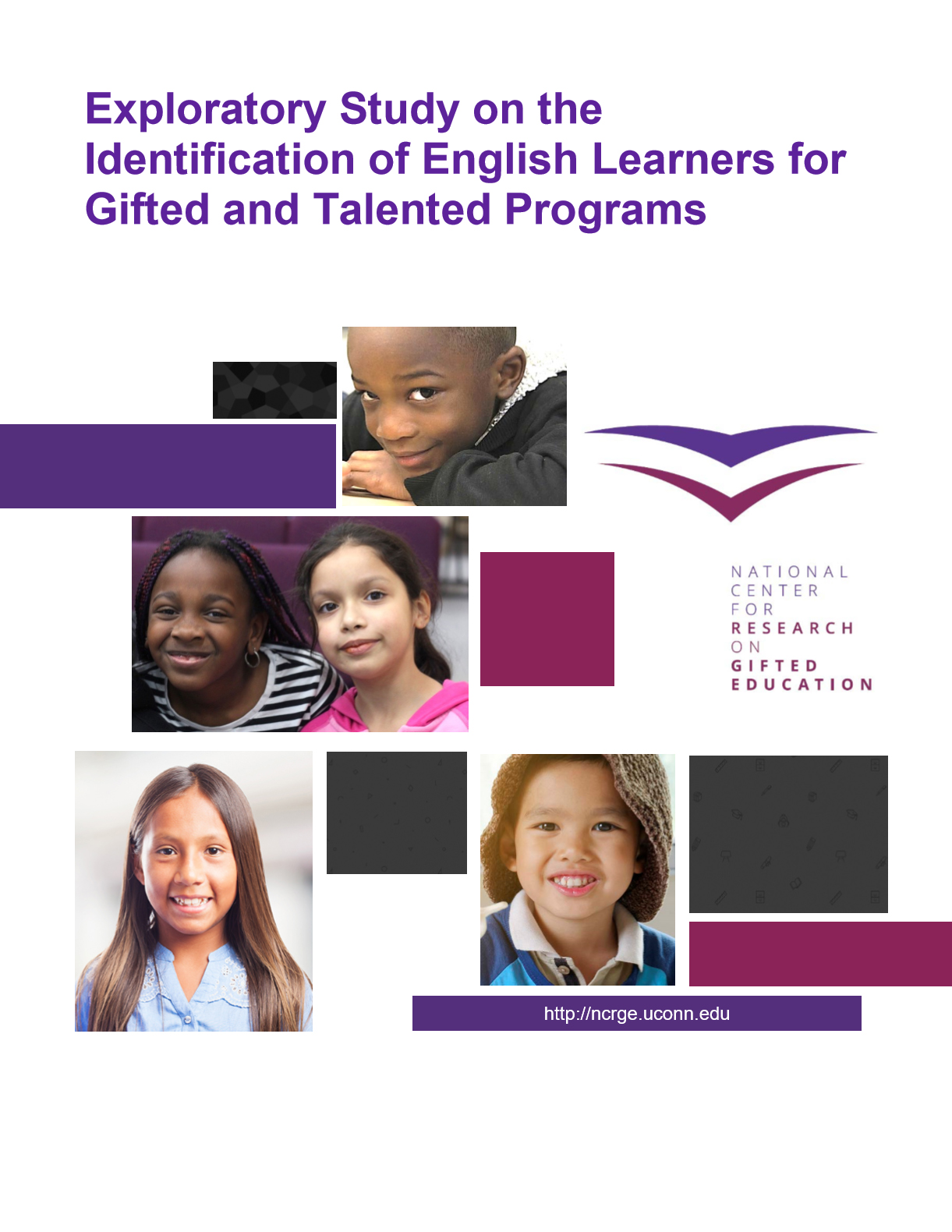
Exploratory Study on the Identification of English Learners for Gifted and Talented Programs
2018 Publication of the National Center for Research on Gifted Education
E. Jean Gubbins, Del Siegle, Rashea Hamilton, Pamela Peters, Ashley Y. Carpenter, Patricia O’Rourke, Jeb Puryear, D. Betsy McCoach, Daniel Long, Emma Bloomfield, Karen Cross, Rachel U. Mun, Christina Amspaugh, Susan Dulong Langley, Anne Roberts, and William Estepar-Garcia
